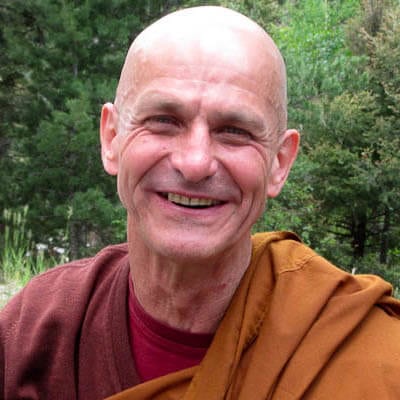The Buddha’s teachings offer tools to individuals for an objective investigation of the factors that drive their actions at the individual level. Particularly, meditation practices allow people to better comprehend and redirect the motivations and drivers that influence their observations, interpretations, and decision-making. In general, Buddhism emphasizes the transformation of the individual as the starting point for change at the collective level. 1Till Markus, Bhikkhu Vivekananda, and Mark Lawrence, “An Assessment of Climate Engineering from a Buddhist Perspective,” Journal for the Study of Religion, Nature, and Culture 12 (2018): 27.
The development of contentment may contribute to a reduction in consumption of material, consumer goods, and also energy generation.
This emphasis on individual transformation provides a framework for considering how to approach climate engineering. For example, the first precept—to abandon the taking of life and to be conscientious of the welfare of all living beings—strongly suggests that climate engineering technologies must not be developed for military or violent purposes. The first precept also implies that a potential application of climate engineering techniques, even if done in “self-defense” against those who continue to emit greenhouse gases, should only be carried out under the condition that one has absolutely no intent to harm others. This does not provide a principle of absolute opposition to the implementation of climate engineering, but sets an additional, very high hurdle for its implementation.2Ibid.
Furthermore, the five precepts, the respect for life, and the four qualities of loving kindness, compassion, sympathetic joy, and equanimity are universal in nature. Human beings are seen as being a part of nature. Hence, our relationships across societies should be one of equality, free of discrimination, where developing societies are as important as wealthy societies.
Determining Acceptable Strategies

In order to respect fundamental equality, any form of climate engineering research or deployment should not be imposed by some against the will of others and should not be to the disadvantage of developing nations. This sets a further, nearly insurmountable hurdle if taken literally, but when interpreted more broadly in the context of the global society, any kind of climate engineering research or deployment that possibly affects others should be legitimized through some form of common governance structure (e.g. the United Nations) and not unilaterally. Within this structure, states and other possible relevant entities representing people should be able to jointly assess and mutually determine which effects of climate engineering measures they potentially deem acceptable. This would include, inter alia, the political, economic, ethical and legal evaluations of specific climate engineering actions and the weighing of their potential effects against other values, ethical concerns, objectives, and even legal requirements. Given the largely unclear costs, risks, and impacts of climate engineering techniques and research, weighing values, concerns, objectives, and legal requirements and ultimately reaching decisions will likely be very challenging. In order to ensure that Buddhist ethics are applied, this process would need to be carried out carefully and with the mindsets discussed above (i.e. with considerations such as compassion, loving kindness, and precaution).3Ibid., 28
Future generations have the right to be passed on a healthy environment.
One may argue that emissions reduction strategies outrank climate engineering measures since they primarily aim at limiting, eliminating, or reversing the actions that lead to the unwanted effects. Similarly, adaptation strategies help to make the negative consequences of climate change more bearable, without imposing new, potentially harmful effects on the environment on a large scale. Furthermore, within the group of climate engineering measures, based on these principles, one would generally prioritize carbon removal techniques, which are largely targeted at reversing the chain of damage causes by carbon dioxide emissions by removing it from the atmosphere. A lower priority would be placed on solar radiation management techniques, which introduce further perturbations to the environment (e.g., modifying aerosol particle layers and clouds) in exchange for reducing other existing perturbations (e.g., increased temperatures). However, this is not completely unambiguous: especially biomass-based carbon dioxide removal techniques can also be seen as causing perturbations to ecosystems in exchange for the removal of carbon dioxide from the atmosphere. Nevertheless, carbon dioxide removal techniques are generally focused closer to the cause end in the chain of cause and effect, and thus will likely generally be favored over solar radiation management techniques in future detailed analyses based on Buddhist ethics on a case-by-case basis. It is interesting to note that favoring carbon dioxide removal over solar radiation management reflects the current general tenor of the international discourse of climate engineering.4Ibid.
Intergenerational Risks

One of the most commonly discussed forms of solar radiation management is stratospheric aerosol injection. While stratospheric aerosol injection and related measures have the potential to avert “climate emergencies,” or to serve as a stopgap measure to buy time for effective emissions mitigation responses, they also pose serious risks. Stratospheric aerosol injection involves increasing the amount of aerosol particles in the lower stratosphere (at altitudes above about 20 km) as a means to increase the reflection of sunlight beyond what is reflected by the naturally occurring stratospheric aerosol layer. Particles could either be injected directly or formed via injection of precursor gases such as sulfur dioxide (SO2), which are then converted into particles.5Stefan Schäfer, Mark Lawrence, Harald Stelzer, Wanda Born, and Sean Low (eds.), The European Transdisciplinary Assessment of Climate Engineering (EuTRACE): Removing Greenhouse Gases from the Atmosphere and Reflecting Sunlight away from Earth, Funded by the European Union’s Seventh Framework Programme under Grant Agreement 306993 (EuTRACE, 2015), 41 Many commentators have focused on intergenerational risks, such as changes in precipitation patterns, or increases in sulphur dioxide loads in the troposphere. Future generations have the right to be passed on a healthy environment. However, solar radiation management approaches like this may also pose grave threats to future generations should their use ultimately cease without concomitant reductions in greenhouse emissions, termed the so-called “rebound effect.” This would amount to depriving future generations of a healthy environment, which would be in violation of the second Buddhist precept as well as the international legal principle of intergenerational equity.6William Burns, “Solar Radiation Management and Intergenerational Equity,” accessed November 22, 2018, https://www.spp-climate-engineering.de/files/ce-projekt/media/download_PDFs/CERSYM%20PresentationTeil8.pdf.
With a view to the institutional and procedural aspect of governing climate engineering, the fourth precept, i.e. abandoning false speech, suggests increasing transparency, providing opportunities to participate and making available information to those potentially affected throughout all stages of all related activities. The realization of this precept could be furthered, for example, by promoting publicly available scientific research.7Markus et al., “An Assessment of Climate Engineering,” 29.
The cultivation of the mind may lead to the realization that the consumption of consumer goods or energy ultimately does not lead to inner happiness. When true inner happiness arises fewness of desires (appichatā) and contentment (santutthi) follow naturally. The development of contentment may contribute to a reduction in consumption of material, consumer goods, and also energy generation.
In summary, Buddhist teachings are setting high hurdles for the research and deployment of climate engineering measures and instead advocate changes in human behavior towards the environment and changes of lifestyle.
This article was originally published on GreenFaith. It is reprinted here with permission.
References
- 1Till Markus, Bhikkhu Vivekananda, and Mark Lawrence, “An Assessment of Climate Engineering from a Buddhist Perspective,” Journal for the Study of Religion, Nature, and Culture 12 (2018): 27.
- 2Ibid.
- 3Ibid., 28
- 4Ibid.
- 5Stefan Schäfer, Mark Lawrence, Harald Stelzer, Wanda Born, and Sean Low (eds.), The European Transdisciplinary Assessment of Climate Engineering (EuTRACE): Removing Greenhouse Gases from the Atmosphere and Reflecting Sunlight away from Earth, Funded by the European Union’s Seventh Framework Programme under Grant Agreement 306993 (EuTRACE, 2015), 41
- 6William Burns, “Solar Radiation Management and Intergenerational Equity,” accessed November 22, 2018, https://www.spp-climate-engineering.de/files/ce-projekt/media/download_PDFs/CERSYM%20PresentationTeil8.pdf.
- 7Markus et al., “An Assessment of Climate Engineering,” 29.






